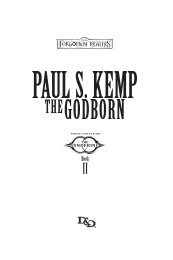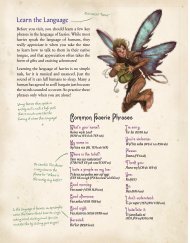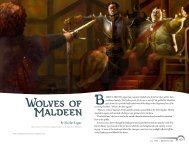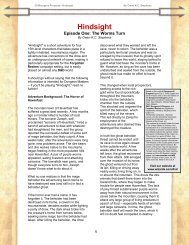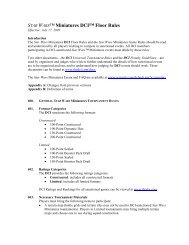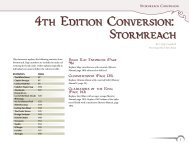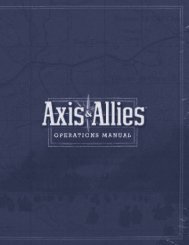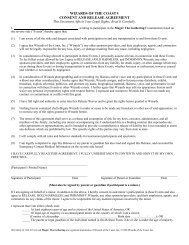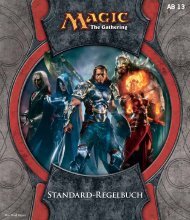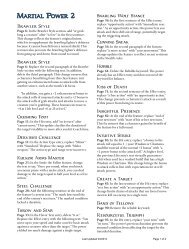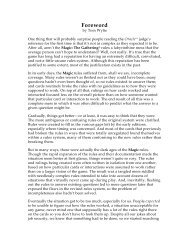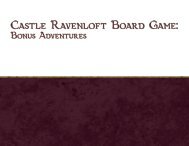Axis & Allies Guadalcanal Rulebook - Wizards of the Coast
Axis & Allies Guadalcanal Rulebook - Wizards of the Coast
Axis & Allies Guadalcanal Rulebook - Wizards of the Coast
Create successful ePaper yourself
Turn your PDF publications into a flip-book with our unique Google optimized e-Paper software.
Questions?<br />
U.S., Canada, Asia Pacifi c & Latin America<br />
www.wizards.com/customerservice<br />
<strong>Wizards</strong> <strong>of</strong> <strong>the</strong> <strong>Coast</strong>, Inc.<br />
P.O. Box 707<br />
Renton WA 98057-0707<br />
U.S.A.<br />
Tel: 1-800-324-6496 (within <strong>the</strong> U.S.)<br />
1-206-624-0933 (outside <strong>the</strong> U.S.)<br />
U.K., Eire & South Africa<br />
Hasbro UK Ltd.<br />
P.O. Box 43<br />
Newport, NP19 4YD<br />
UK<br />
Tel: + 800 22 427276<br />
Email: wizards@hasbro.co.uk<br />
All O<strong>the</strong>r European Countries<br />
<strong>Wizards</strong> <strong>of</strong> <strong>the</strong> <strong>Coast</strong> p/a Hasbro Belgium NV/SA<br />
’t H<strong>of</strong>veld 6D<br />
1702 Groot-Bijgaarden<br />
BELGIUM<br />
Tel: +32.70.233.277<br />
Email: custserv@hasbro.be<br />
®<br />
Keep <strong>the</strong>se addresses for your records.<br />
www.avalonhill.com<br />
Color <strong>of</strong> parts may vary from those pictured.<br />
©2007 <strong>Wizards</strong> <strong>of</strong> <strong>the</strong> <strong>Coast</strong>, Inc., P.O. Box 707, Renton, WA 98057-0707. <strong>Wizards</strong> <strong>of</strong> <strong>the</strong> <strong>Coast</strong><br />
and its logo are trademarks <strong>of</strong> <strong>Wizards</strong> <strong>of</strong> <strong>the</strong> <strong>Coast</strong>, Inc., in <strong>the</strong> U.S.A. and o<strong>the</strong>r countries.<br />
Avalon Hill, <strong>Axis</strong> & <strong>Allies</strong>, Hasbro, and <strong>the</strong>ir logos are trademarks <strong>of</strong> Hasbro, Inc. ® denotes<br />
Reg. U.S. Pat. & Offi ce. All rights reserved. MADE IN CHINA.<br />
30095774000001EN<br />
®<br />
AGE 13+<br />
TIME 2–3 HOURS<br />
2 PLAYERS<br />
®
TABLE OF CONTENTS<br />
Object <strong>of</strong> <strong>the</strong> Game ............................................................................3<br />
Summary <strong>of</strong> Play .......................................................................3<br />
How to Win ................................................................................3<br />
Game Components ............................................................................4<br />
Game Setup .........................................................................................8<br />
Units.......................................................................................................9<br />
Land Units ..................................................................................9<br />
Sea Units ..................................................................................10<br />
Air Units ..................................................................................13<br />
Sequence <strong>of</strong> Play .............................................................................14<br />
Phase 1: Movement ..................................................................14<br />
Phase 2: Combat ......................................................................16<br />
Phase 3: Regroup .....................................................................21<br />
Appendix 1: Optional Rules ............................................................24<br />
Advantage Tokens ....................................................................24<br />
Hidden Movement ...................................................................25<br />
Appendix 2: Battle Box Results Chart .........................................25<br />
Appendix 3: Designer’s Notes .......................................................26<br />
CREDITS<br />
Game Design: Larry Harris<br />
Game Development: Nate Heiss and Bill McQuillan<br />
Additional Playtesting: Steve Warner, Mons Johnson, Gregory<br />
Marques, Rich Baker, Scott Larabee, Erik Lauer, Mike Turian, Frank<br />
Gilson, Graeme Hopkins, Alan Comer, and Courtenay Moore<br />
Editing: Bill McQuillan<br />
Art Direction: Blake Beasley<br />
Cover Illustration: Tommy Lee Edwards<br />
Graphic Designer: Scott Okumura<br />
Brand Management: Linda Cox, Laura Tommervik, and Brian Hart<br />
Production Management: Bob Carrasca<br />
Thanks to all <strong>of</strong> our project team members and <strong>the</strong> many o<strong>the</strong>rs too<br />
numerous to mention who have contributed to this product.<br />
OBJECT OF THE GAME<br />
It is August 1942 and Japan<br />
has occupied much <strong>of</strong> <strong>the</strong><br />
Solomon Islands chain. The goals<br />
<strong>of</strong> <strong>the</strong> occupation are to protect<br />
<strong>the</strong> fl ank <strong>of</strong> <strong>the</strong> Japanese <strong>of</strong>fensive<br />
in New Guinea, form a security<br />
barrier for <strong>the</strong> Japanese base at<br />
Rabaul, and interfere with Allied<br />
supply lines. The United States<br />
has just begun its counterattack<br />
with a surprise landing on<br />
<strong>Guadalcanal</strong>, capturing <strong>the</strong><br />
under-construction airfi eld <strong>the</strong>re,<br />
which will later be renamed<br />
Henderson Field.<br />
Summary <strong>of</strong> Play<br />
An <strong>Axis</strong> & <strong>Allies</strong>: <strong>Guadalcanal</strong><br />
game generally lasts 4 to 6 turns.<br />
Each turn, <strong>the</strong> players alternate<br />
moving <strong>the</strong>ir units, one unit<br />
type at a time. Combat occurs in<br />
contested zones in three stages—<br />
air, sea, and <strong>the</strong>n land—in an<br />
attempt to seize control <strong>of</strong> <strong>the</strong><br />
island zones and <strong>the</strong> all-important<br />
airfi elds. Finally, <strong>the</strong> players will<br />
call for reinforcements and build<br />
more airfi elds.<br />
How to Win<br />
The fi rst player to reach 15 victory<br />
points wins. You earn victory<br />
points by controlling airfi elds<br />
and destroying capital ships<br />
(battleships and aircraft carriers).<br />
2 3
GAME COMPONENTS GAME COMPONENTS (continued)<br />
1 Game Board<br />
1 <strong>Rulebook</strong><br />
1 Storage Tray<br />
1 Battle Box<br />
12 Dice<br />
2 Base Cards (Rabaul and New Caledonia)<br />
2 Reference Charts<br />
1 First-Player Token<br />
2 Victory Point Markers<br />
6 Control Markers<br />
9 Airfi eld Markers<br />
20 Supply Tokens<br />
16 Advantage Tokens<br />
85 Plastic Chips (10 red, 75 grey)<br />
85 Total <strong>Allies</strong> Playing Pieces (green):<br />
6 Battleships 10 Transports 10 Infantry<br />
5 Aircraft Carriers 8 Submarines 7 Artillery<br />
10 Destroyers 8 Fighters 6 Antiaircraft Guns<br />
8 Cruisers 7 Bombers<br />
87 Total <strong>Axis</strong> Playing Pieces (brown):<br />
6 Battleships 10 Transports 12 Infantry<br />
5 Aircraft Carriers 8 Submarines 7 Artillery<br />
10 Destroyers 8 Fighters 6 Antiaircraft Guns<br />
8 Cruisers 7 Bombers<br />
4 5
GAME COMPONENTS (continued)<br />
Game Board<br />
The game board is a map <strong>of</strong> <strong>the</strong> Solomon Islands in <strong>the</strong> South Pacifi c.<br />
Sea Zone<br />
These are marked with <strong>the</strong> letters<br />
A through M for reference. Sea<br />
and air units can enter sea zones.<br />
Land units can enter sea zones<br />
only if <strong>the</strong>y’re being carried by<br />
destroyers or transports.<br />
Route to Base<br />
The United States and Japan have route-to-base zones on opposite<br />
ends <strong>of</strong> <strong>the</strong> game board. These sea zones connect with <strong>the</strong> waters on<br />
<strong>the</strong> appropriate base card.<br />
Island Zone<br />
Each <strong>of</strong> <strong>the</strong>se has a name and<br />
an airfi eld capacity. For example,<br />
up to 2 airfi elds can be put on<br />
<strong>Guadalcanal</strong>. Controlling island<br />
zones will grant you more<br />
reinforcement points.<br />
GAME COMPONENTS (continued)<br />
Base Cards (Rabaul and New Caledonia)<br />
These serve as each country’s launching point for <strong>the</strong> Solomon Islands<br />
campaign. Each card represents a base that is much fur<strong>the</strong>r away than a<br />
normal sea zone, but moving from its sea zone to its connecting route-tobase<br />
sea zone on <strong>the</strong> board takes just 1 movement. Your base also houses<br />
damaged units for repair and is where you place your reinforcements<br />
when you purchase <strong>the</strong>m.<br />
Airfi eld Markers<br />
If you control <strong>the</strong> airfi elds,<br />
you control <strong>the</strong> war. Each undamaged<br />
airfi eld can hold up to 2 aircraft and is worth 1 victory<br />
point per turn.<br />
Supply Tokens<br />
Use <strong>the</strong>se for building and repairing airfi elds,<br />
repairing damaged sea units, and for expediting<br />
<strong>the</strong> deployment <strong>of</strong> reinforcements. They can be<br />
carried on destroyers and transports. Spent supply<br />
tokens are returned to <strong>the</strong> game box.<br />
First-Player Token<br />
The player who has this will move each type <strong>of</strong><br />
unit fi rst and will choose <strong>the</strong> order <strong>of</strong> zones when<br />
resolving combat.<br />
Control Markers<br />
Use <strong>the</strong>se during <strong>the</strong> fi nal phase <strong>of</strong> each turn<br />
to indicate control <strong>of</strong> <strong>the</strong> island zones.<br />
Advantage Tokens<br />
Use <strong>the</strong>se for optional rules to add a twist to game play.<br />
(See page 24.)<br />
1 destroyer unit<br />
grey chip (1 unit)<br />
Victory Track<br />
The fi rst player to reach 15 victory points wins. You earn victory points<br />
by controlling airfi elds and destroying capital ships.<br />
2 Destroyers 7 Infantry<br />
6 7<br />
1st<br />
Player<br />
Battle Box and Dice<br />
Use <strong>the</strong> battle box to determine<br />
<strong>the</strong> results <strong>of</strong> combat. Place <strong>the</strong> 12<br />
dice in <strong>the</strong> neck <strong>of</strong> <strong>the</strong> battle box,<br />
and <strong>the</strong>n slide it in.<br />
Plastic Chips<br />
Use <strong>the</strong>se to save space in<br />
overcrowded zones. Putting a<br />
grey chip under a unit shows that<br />
<strong>the</strong>re is an additional unit <strong>of</strong> that<br />
unit type in <strong>the</strong> zone. Putting a red<br />
chip under a unit shows that <strong>the</strong>re<br />
are an additional fi ve units <strong>of</strong> that<br />
unit type in <strong>the</strong> hex.<br />
Example: A destroyer with 1<br />
grey chip under it counts as 2<br />
destroyers. An infantry with<br />
1 grey and 1 red chip under it<br />
counts as 7 infantry.<br />
1 infantry unit<br />
red chip (5 units)<br />
grey chip (1 unit)
GAME SETUP<br />
• Decide who will play <strong>the</strong> <strong>Axis</strong><br />
and who will play <strong>the</strong> <strong>Allies</strong>. Sit<br />
on <strong>the</strong> appropriate side <strong>of</strong> <strong>the</strong><br />
board.<br />
• Give <strong>the</strong> <strong>Axis</strong> player <strong>the</strong> fi rstplayer<br />
token.<br />
• Put your base card adjacent to<br />
your route-to-base zone(s).<br />
• Put <strong>the</strong> victory-track markers<br />
on <strong>the</strong> victory tracks.<br />
• Put 1 airfi eld marker on<br />
<strong>Guadalcanal</strong> and 1 on<br />
Bougainville. The <strong>Allies</strong><br />
player controls <strong>the</strong> airfi eld<br />
on <strong>Guadalcanal</strong> and <strong>the</strong> <strong>Axis</strong><br />
player controls <strong>the</strong> airfi eld on<br />
Bougainville.<br />
• Put an <strong>Allies</strong> control marker on<br />
<strong>Guadalcanal</strong> and <strong>Axis</strong> control<br />
markers on <strong>the</strong> o<strong>the</strong>r islands.<br />
• Put units on <strong>the</strong> board as<br />
indicated by <strong>the</strong> printed<br />
silhouettes, using plastic chips<br />
as needed.<br />
• Put <strong>the</strong> 12 dice into <strong>the</strong> battle<br />
box.<br />
2 Destroyers<br />
1 Cruiser<br />
2 Transports<br />
Land Units<br />
Land units can attack only when in an island zone. They can be carried by transport or destroyer across sea zones.<br />
8 9<br />
UNITS<br />
This section includes detailed information for each<br />
unit in <strong>the</strong> game. Keep any units you aren’t using in<br />
your game box. Whenever a unit gets destroyed, put<br />
it back into <strong>the</strong> game box.<br />
There are three categories <strong>of</strong> units in <strong>the</strong> game:<br />
land, sea, and air. Each unit type is defi ned by <strong>the</strong><br />
following characteristics:<br />
Infantry<br />
<strong>Axis</strong>: Japan <strong>Allies</strong>: United States<br />
Infantry is <strong>the</strong> basic land unit <strong>of</strong> war. They are not effective against air and naval units but are key in capturing<br />
and controlling <strong>the</strong> disputed islands. It is easy to deploy a large number <strong>of</strong> infantry onto <strong>the</strong> battlefi eld.<br />
Cost: 1<br />
Air Attack: 0<br />
Sea Attack: 0<br />
Land Attack: 1<br />
Artillery<br />
<strong>Axis</strong>: 70mm Howitzer <strong>Allies</strong>: 105mm Howitzer<br />
Artillery is <strong>the</strong> most powerful land unit in <strong>the</strong> Solomon Islands campaign. It can infl uence <strong>the</strong> tide <strong>of</strong> battle<br />
both on land and at sea.<br />
Cost: 2<br />
Air Attack: 0<br />
Sea Attack: 1<br />
Land Attack: 1<br />
Cost: This number is <strong>the</strong> unit’s cost in reinforcement<br />
points.<br />
Attack: This is how many dice a unit contributes to<br />
an attack against <strong>the</strong> indicated unit category (land,<br />
sea, and air). Also, land attack power is used to<br />
determine control <strong>of</strong> island zones.<br />
Special Abilities: Some units have special abilities.<br />
Special Abilities<br />
Ranged Fire: May attack into 1 adjacent sea zone each turn during <strong>the</strong> Attack Sea Units step <strong>of</strong> combat.
UNITS (continued) UNITS (continued)<br />
Antiaircraft Guns<br />
Antiaircraft guns provide a powerful umbrella that helps protect your airfi elds and land units from aircraft assaults.<br />
Cost: 2<br />
Air Attack: 3<br />
Sea Attack: 0<br />
Land Attack: 0<br />
Sea Units<br />
Each sea unit can move 1 sea zone per movement phase. They can never move into island zones.<br />
Transport<br />
<strong>Axis</strong>: Hakusan Maru class <strong>Allies</strong>: Liberty Ship<br />
Island warfare is all about <strong>the</strong> transports. Land troops can’t maneuver between islands without <strong>the</strong>m. All <strong>the</strong><br />
o<strong>the</strong>r ships and planes are <strong>the</strong>re to make sure <strong>the</strong>se key units can carry <strong>the</strong> war to <strong>the</strong> enemy.<br />
Cost: 2<br />
Air Attack: 0<br />
Sea Attack: 0<br />
Land Attack: 0<br />
Special Abilities<br />
Transportation: A transport has 2 spaces for transporting land units and supplies. Each unit or supply token<br />
takes up 1 space.<br />
Submarine<br />
<strong>Axis</strong>: I class <strong>Allies</strong>: Ray class<br />
This unit has its own particular way <strong>of</strong> conducting war. These lone wolves can target specifi c ships and cause<br />
great problems for an unsuspecting target.<br />
Cost: 4<br />
Air Attack: 0<br />
Sea Attack: 0<br />
Land Attack: 0<br />
Special Abilities<br />
Torpedo Attack: After moving (or deciding not to move), a submarine makes a 1-die attack on <strong>the</strong> target <strong>of</strong><br />
your choice in <strong>the</strong> same sea zone. This special attack happens during <strong>the</strong> movement phase, so a unit damaged<br />
or destroyed by this attack will be removed from <strong>the</strong> zone before it can attack.<br />
10 11<br />
Destroyer<br />
<strong>Axis</strong>: Fubuki class <strong>Allies</strong>: Johnston class<br />
A naval task force with a good ratio <strong>of</strong> destroyers will always prove to be a deadly force. Intentionally limited<br />
in both land and air attack abilities—jobs best left to <strong>the</strong> cruisers and battleships—destroyers are <strong>the</strong> infantry in<br />
a world where <strong>the</strong> oceans are <strong>the</strong> battlefi elds.<br />
Cost: 5<br />
Air Attack: 1<br />
Sea Attack: 1<br />
Land Attack: 0<br />
Special Abilities<br />
Makeshift Transport: A destroyer has 1 space for transporting a land unit or supply token.<br />
Resilience: Damaged instead <strong>of</strong> destroyed on a hit roll <strong>of</strong> 2.<br />
Cruiser<br />
<strong>Axis</strong>: Takao class <strong>Allies</strong>: Portland class<br />
With <strong>the</strong> ability to participate in land, sea, and air battles, <strong>the</strong>se warships will have a lasting impact on all three<br />
dimensions <strong>of</strong> this struggle.<br />
Cost: 7<br />
Air Attack: 1<br />
Sea Attack: 2<br />
Land Attack: 1<br />
Special Abilities<br />
Ranged Fire: May attack into 1 adjacent island zone each turn during <strong>the</strong> Attack Land Units step <strong>of</strong> combat.<br />
Resilience: Damaged instead <strong>of</strong> destroyed on a hit roll <strong>of</strong> 2.
UNITS (continued)<br />
Aircraft Carrier (Capital Ship)<br />
<strong>Axis</strong>: Shinano class <strong>Allies</strong>: Wasp class<br />
Capable <strong>of</strong> transporting fi ghter aircraft to any island or sea zone on <strong>the</strong> battlefi eld, <strong>the</strong>se capital ships are<br />
indeed <strong>the</strong> heart and soul <strong>of</strong> <strong>the</strong> fl eet. Protect <strong>the</strong>m well!<br />
Cost: 7<br />
Air Attack: 0<br />
Sea Attack: 0<br />
Land Attack: 0<br />
Special Abilities<br />
Flight Deck: Up to 2 fi ghters can land on a friendly aircraft carrier.<br />
Capital Ship: Your opponent earns 1 victory point for destroying a capital ship.<br />
Resilience: Damaged instead <strong>of</strong> destroyed on a hit roll <strong>of</strong> 2.<br />
Battleship (Capital Ship)<br />
<strong>Axis</strong>: Yamato class <strong>Allies</strong>: Iowa class<br />
These capital war ships are <strong>the</strong> cornerstones <strong>of</strong> power. The presence <strong>of</strong> a battleship in a given sea zone will<br />
always signal <strong>the</strong> ultimate effort and center <strong>of</strong> activity.<br />
Cost: 12<br />
Air Attack: 1<br />
Sea Attack: 3<br />
Land Attack: 2<br />
Special Abilities<br />
Ranged Fire: May attack into 1 adjacent island zone each turn during <strong>the</strong> Attack Land Units step <strong>of</strong> combat.<br />
Heavy Armor: Ignore <strong>the</strong> fi rst hit on a battleship each turn (a roll <strong>of</strong> 1 or 2).<br />
Capital Ship: Your opponent earns 1 victory point for destroying a capital ship.<br />
Resilience: Damaged instead <strong>of</strong> destroyed on a hit roll <strong>of</strong> 2.<br />
UNITS (continued)<br />
Air Units<br />
Fighters and bombers can move into and attack island zones or sea zones. They can land on airfi elds you<br />
control and on <strong>the</strong> land zone <strong>of</strong> your base card. Fighters can also land on your aircraft carriers.<br />
12 13<br />
Bomber<br />
<strong>Axis</strong>: G4M2E Model 24J “Betty” <strong>Allies</strong>: B-17<br />
Transporting powerful payloads over great distances, bombers can turn <strong>the</strong> tide <strong>of</strong> any battle—be it on land,<br />
sea, or air. They will be your powerful fi st ready to strike where and when <strong>the</strong>y are needed.<br />
Cost: 5<br />
Air Attack: 1<br />
Sea Attack: 2<br />
Land Attack: 2<br />
Special Abilities<br />
Range 3: Can move up to 3 zones during movement and 3 zones during regroup.<br />
Fighter<br />
<strong>Axis</strong>: A6M2 Zero-Sen “Zero” <strong>Allies</strong>: Carrier Based Fighter<br />
Land-based or fl ying <strong>of</strong>f <strong>the</strong> decks <strong>of</strong> carriers, <strong>the</strong>se weapons will dictate <strong>the</strong> terms <strong>of</strong> any engagement. In <strong>the</strong><br />
end, <strong>the</strong>se machines replaced ships as <strong>the</strong> dominant weapons <strong>of</strong> <strong>the</strong> time.<br />
Cost: 3<br />
Air Attack: 2<br />
Sea Attack: 1<br />
Land Attack: 1<br />
Special Abilities<br />
Range 2: Can move up to 2 zones during movement and 2 zones during regroup.
SEQUENCE OF PLAY<br />
<strong>Axis</strong> & <strong>Allies</strong>: <strong>Guadalcanal</strong> is<br />
played in turns. A turn consists <strong>of</strong><br />
3 phases, followed in order.<br />
Turn Order<br />
Phase 1: Movement<br />
Phase 2: Combat<br />
Phase 3: Regroup<br />
Phase 1: Movement<br />
In this phase, <strong>the</strong> players alternate<br />
moving <strong>the</strong>ir units by unit type.<br />
How an individual unit moves<br />
depends on whe<strong>the</strong>r it’s a sea, air,<br />
or land unit.<br />
• Sea unit: May move 1 sea zone.<br />
• Air unit: May move multiple<br />
zones and can move into sea<br />
and island zones.<br />
• Land unit: May only be moved<br />
by transport or destroyer.<br />
The sea zone on your base card<br />
is one move away from <strong>the</strong> routeto-base<br />
sea zone(s) indicated on<br />
<strong>the</strong> board.<br />
Movement Sequence<br />
1. Load and move transports<br />
2. Move battleships<br />
3. Move aircraft carriers<br />
4. Move cruisers<br />
5. Load and move destroyers<br />
6. Move and attack with<br />
submarines<br />
7. Move bombers<br />
8. Move fi ghters<br />
For each step <strong>of</strong> <strong>the</strong> movement<br />
sequence, <strong>the</strong> fi rst player<br />
completes that step for his or her<br />
own units, and <strong>the</strong>n <strong>the</strong> o<strong>the</strong>r<br />
player does <strong>the</strong> same. Then go to<br />
<strong>the</strong> next step <strong>of</strong> <strong>the</strong> sequence.<br />
When you fi nish a given step, let<br />
your opponent know it is his or<br />
her turn.<br />
1. Load and Move Transports<br />
You may load land units and<br />
supplies from adjacent island<br />
zones onto transports. Each<br />
transport has 2 spaces for<br />
transporting land units and<br />
supplies. Each unit or supply<br />
token takes up 1 space.<br />
Put <strong>the</strong> units you wish to load on<br />
a transport into <strong>the</strong> sea zone next<br />
to <strong>the</strong> transport. If you’re loading<br />
multiple transports in <strong>the</strong> same<br />
sea zone, indicate exactly how<br />
you’re splitting up <strong>the</strong> units and<br />
supplies among <strong>the</strong> transports.<br />
This is important in case any <strong>of</strong><br />
<strong>the</strong> transports are destroyed and<br />
you need to determine which<br />
cargo is lost.<br />
When you move a loaded<br />
transport to a different sea zone,<br />
keep <strong>the</strong> loaded units next to <strong>the</strong><br />
transport.<br />
2. Move Battleships<br />
Battleships don’t have any special<br />
movement rules. They can simply<br />
move 1 sea zone.<br />
3. Move Aircraft Carriers<br />
Any fi ghters that are loaded on<br />
<strong>the</strong> carrier move along with <strong>the</strong><br />
carrier for free into <strong>the</strong> new zone<br />
it moves into.<br />
4. Move Cruisers<br />
Cruisers don’t have any special<br />
movement rules. They can simply<br />
move 1 sea zone.<br />
5. Load and Move Destroyers<br />
Load and move destroyers like you<br />
did transports, except destroyers<br />
have less space. Each destroyer<br />
has only 1 space for transporting a<br />
land unit or supply token.<br />
SEQUENCE OF PLAY (continued)<br />
This battleship can’t move through New<br />
Georgia from sea zone I to sea zone G, because<br />
<strong>the</strong> island zone is between those zones.<br />
6. Move and Attack with<br />
Submarines<br />
A submarine attack is a special<br />
1-die attack on a sea unit <strong>of</strong> your<br />
choice in <strong>the</strong> zone <strong>the</strong> submarine<br />
is in. The submarine may make<br />
this attack even if it does not<br />
move, but it happens after you<br />
move, or declare that you’re not<br />
moving, <strong>the</strong> submarine. Choose<br />
a sea unit in <strong>the</strong> zone and roll <strong>the</strong><br />
dice in <strong>the</strong> battle box. Apply <strong>the</strong><br />
result <strong>of</strong> <strong>the</strong> fi rst die in <strong>the</strong> box to<br />
<strong>the</strong> target you chose. Read more<br />
about attacks and how <strong>the</strong>y work<br />
on page 16.<br />
7. Move Bombers<br />
A bomber moves up to 3 zones.<br />
8. Move Fighters<br />
Examples <strong>of</strong> Sea Movement<br />
You have a fi ghter on<br />
New Caledonia and<br />
you want to move it<br />
onto <strong>the</strong> game board.<br />
The fi rst move is<br />
into <strong>the</strong> sea zone on<br />
<strong>the</strong> New Caledonia<br />
card, and <strong>the</strong> second<br />
is into sea zone J.<br />
Later in <strong>the</strong> turn,<br />
during <strong>the</strong> regroup<br />
phase, <strong>the</strong> fi ghter can<br />
move ano<strong>the</strong>r 2 zones<br />
to land, allowing<br />
it to land on your<br />
<strong>Guadalcanal</strong> airfi eld.<br />
This cruiser moves 1 zone<br />
from <strong>the</strong> U.S. base card<br />
to sea zone J.<br />
Likewise, a sea unit couldn’t move from sea<br />
zone C to sea zone H.<br />
Example <strong>of</strong> Air Movement<br />
A fi ghter moves up to 2 zones.<br />
14 15
SEQUENCE OF PLAY (continued)<br />
Phase 2: Combat<br />
In this phase, resolve combat in<br />
each zone that contains opposing<br />
units.<br />
Combat Sequence<br />
1. Attack air units<br />
2. Attack sea units<br />
3. Unload transports and<br />
destroyers<br />
4. Attack land units and/or<br />
airfi elds<br />
For each step <strong>of</strong> <strong>the</strong> combat<br />
sequence, <strong>the</strong> fi rst player chooses<br />
<strong>the</strong> order in which zones are<br />
resolved. For details on how<br />
attacks are resolved, see How to<br />
Attack on <strong>the</strong> next page.<br />
1. Attack Air Units<br />
The fi rst player attacks <strong>the</strong><br />
opposing air units in <strong>the</strong> zone <strong>of</strong><br />
his or her choice. Then <strong>the</strong> o<strong>the</strong>r<br />
player attacks <strong>the</strong> opposing air<br />
units in that zone. After both<br />
players have rolled <strong>the</strong>ir attacks,<br />
<strong>the</strong>n remove <strong>the</strong> destroyed air<br />
units from <strong>the</strong> board. Repeat this<br />
process for each zone in which air<br />
units can be fi red upon.<br />
2. Attack Sea Units<br />
Do what you did for air units<br />
in step 1, but this time for each<br />
sea zone in which sea units can<br />
be fi red upon. Also, some sea<br />
units can be damaged instead<br />
<strong>of</strong> destroyed. Put <strong>the</strong>m on <strong>the</strong><br />
damaged area <strong>of</strong> <strong>the</strong>ir base cards<br />
at <strong>the</strong> same time you remove<br />
destroyed sea units.<br />
Each artillery may fi re into only<br />
1 adjacent sea zone each turn.<br />
The attacker must declare if <strong>the</strong><br />
artillery is part <strong>of</strong> <strong>the</strong> attack for<br />
each sea zone adjacent to it. Once<br />
declared as part <strong>of</strong> an attack on a<br />
sea zone, an artillery can’t attack<br />
ano<strong>the</strong>r sea zone this turn.<br />
3. Unload Transports and<br />
Destroyers<br />
The fi rst player may unload units<br />
and supply tokens from transports<br />
and destroyers onto adjacent<br />
island zones. The o<strong>the</strong>r player<br />
<strong>the</strong>n does <strong>the</strong> same.<br />
4. Attack Land Units and/or<br />
Airfi elds<br />
Do what you did for air and sea<br />
units in steps 1 and 2, but this<br />
time for each island zone in which<br />
land units and/or airfi elds can be<br />
fi red upon. For each <strong>of</strong> your air<br />
units and sea units participating in<br />
<strong>the</strong> attack (not land units), decide<br />
whe<strong>the</strong>r it will attack <strong>the</strong> enemy’s<br />
land units or airfi elds. It can’t<br />
attack both.<br />
When attacking airfi elds, <strong>the</strong><br />
attack is made with <strong>the</strong> combined<br />
attack power <strong>of</strong> each unit chosen<br />
to attack <strong>the</strong> airfi elds in <strong>the</strong> island<br />
zone. Ignore <strong>the</strong> unit types listed<br />
on <strong>the</strong> neck <strong>of</strong> <strong>the</strong> battle box when<br />
attacking airfi elds. Simply look<br />
at a number <strong>of</strong> dice in a row—<br />
starting with <strong>the</strong> outside tip <strong>of</strong> <strong>the</strong><br />
neck—equal to <strong>the</strong> attack power.<br />
For every 2 hits scored on those<br />
dice (a roll <strong>of</strong> 1 or 2) damage one<br />
enemy-controlled airfi eld in <strong>the</strong><br />
zone. Flip <strong>the</strong> airfi eld marker over<br />
to indicate that it is damaged.<br />
Each cruiser or battleship may<br />
fi re into only 1 adjacent island<br />
zone each turn. The attacker must<br />
declare if <strong>the</strong> cruiser or battleship<br />
is part <strong>of</strong> <strong>the</strong> attack for each island<br />
zone adjacent to it. Once declared<br />
it as part <strong>of</strong> an attack on a island<br />
zone, a cruiser or battleship can’t<br />
attack ano<strong>the</strong>r island zone this turn.<br />
SEQUENCE OF PLAY (continued)<br />
How to Attack<br />
Use <strong>the</strong> following sequence for<br />
resolving attacks against each<br />
category <strong>of</strong> unit—air, sea, and land:<br />
1. Determine Total Attack Power<br />
2. Roll Dice in <strong>the</strong> Battle Box<br />
3. Declare Your Hits<br />
1. Determine Total Attack Power<br />
Add up all <strong>the</strong> attack powers <strong>of</strong><br />
<strong>the</strong> attacking units. That is your<br />
total attack power and determines<br />
how many dice you will be rolling<br />
for that attack.<br />
Each unit has 3 attack numbers.<br />
Each number tells you how many<br />
dice it rolls against <strong>the</strong> indicated<br />
category <strong>of</strong> unit—land, sea, and air.<br />
Example: A battleship has<br />
an air attack power <strong>of</strong> 1. This<br />
means it will add 1 die to your<br />
air attack against all <strong>the</strong> enemy<br />
air units in <strong>the</strong> same zone as<br />
<strong>the</strong> battleship. The battleship<br />
also has a sea attack power <strong>of</strong><br />
3, so it will also add 3 dice to<br />
your attack against <strong>the</strong> enemy<br />
sea units in <strong>the</strong> same zone.<br />
Finally, <strong>the</strong> battleship has a land<br />
attack power <strong>of</strong> 2, so when it is<br />
time to attack land units in an<br />
adjacent island zone, you may<br />
add its 2 dice to your attack in<br />
that zone.<br />
A battleship or cruiser may add its<br />
land attack power to an attack on<br />
1 adjacent island zone<br />
per turn. Similarly, an<br />
artillery may add its<br />
sea attack power to an<br />
attack on 1 adjacent sea<br />
zone per turn. O<strong>the</strong>r<br />
units add <strong>the</strong>ir attack<br />
powers only to attacks<br />
in <strong>the</strong>ir own zones.<br />
2. Roll Dice in <strong>the</strong> Battle Box<br />
Make sure all 12 dice are in<br />
<strong>the</strong> battle box and <strong>the</strong> neck is<br />
fully inserted. Shake <strong>the</strong> box to<br />
randomize <strong>the</strong> dice, tilt <strong>the</strong> box<br />
slightly downward, and <strong>the</strong>n pull<br />
<strong>the</strong> neck out. The dice will come<br />
out in a straight line in <strong>the</strong> neck.<br />
If you have an attack <strong>of</strong> greater<br />
than 12 dice, you’ll need to use<br />
<strong>the</strong> box again until you have<br />
rolled enough dice.<br />
16 17
SEQUENCE OF PLAY (continued) SEQUENCE OF PLAY (continued)<br />
3. Declare Your Hits<br />
Starting with <strong>the</strong> fi rst die at <strong>the</strong><br />
tip <strong>of</strong> <strong>the</strong> neck, check a number <strong>of</strong><br />
dice in a row equal to <strong>the</strong> power<br />
<strong>of</strong> <strong>the</strong> attack. Each die result <strong>of</strong> 1<br />
or 2 is a hit. The inside <strong>of</strong> <strong>the</strong> neck<br />
<strong>of</strong> <strong>the</strong> box is numbered to make<br />
this easier.<br />
Tell your opponent which specifi c<br />
unit types are hit by reading <strong>the</strong>m<br />
<strong>of</strong>f from slot 1 and counting up.<br />
To do this, look at <strong>the</strong> outside<br />
portion <strong>of</strong> <strong>the</strong> neck <strong>of</strong> <strong>the</strong> box<br />
where your hit is positioned. Then<br />
read <strong>of</strong>f <strong>the</strong> unit type indicated on<br />
that slot for <strong>the</strong> category <strong>of</strong> unit<br />
you are attacking (air, sea, or land).<br />
Hitting Units <strong>the</strong> Enemy<br />
Doesn’t Have<br />
During an attack, it’s possible<br />
you’ll hit a unit type your<br />
opponent doesn’t have in that<br />
zone or a type for which all units<br />
in that zone have already been<br />
destroyed. In that case, <strong>the</strong> hit still<br />
counts, but it will hit a different<br />
unit type in that category.<br />
To fi nd out what it hits, look at<br />
<strong>the</strong> unit types listed on <strong>the</strong> neck<br />
<strong>of</strong> <strong>the</strong> battle box. Starting with <strong>the</strong><br />
unit listed for slot 1, look to see<br />
if <strong>the</strong>re is an undestroyed enemy<br />
unit <strong>of</strong> that type present in <strong>the</strong><br />
zone. If so, <strong>the</strong> hit goes to that<br />
unit. Keep reading up <strong>the</strong> neck<br />
from slot to slot until you reach a<br />
type <strong>of</strong> unit in that zone that can<br />
take <strong>the</strong> hit.<br />
Battle Box Example<br />
Example: You are attacking<br />
sea units with 12 dice, and your<br />
opponent has 2 destroyers, 1<br />
cruiser, and 1 battleship in <strong>the</strong><br />
zone you’re attacking. You<br />
score a hit on a transport, which<br />
your opponent doesn’t have in<br />
that zone. This hit will go to a<br />
destroyer, because it’s <strong>the</strong> fi rst<br />
unit type listed on <strong>the</strong> neck <strong>of</strong><br />
<strong>the</strong> box that your opponent has.<br />
Let’s say you attack with a total attack power <strong>of</strong> 8, and you are fi ring at air units. You get this roll:<br />
Since it is an attack with 8 dice, you only need to pay<br />
attention to <strong>the</strong> fi rst 8 dice in <strong>the</strong> neck <strong>of</strong> <strong>the</strong> box.<br />
The fi rst hit was with <strong>the</strong> fi rst die rolled! Look at <strong>the</strong><br />
neck <strong>of</strong> <strong>the</strong> box in <strong>the</strong> slot where that hit is located.<br />
There are three units listed <strong>the</strong>re: fi ghter, destroyer,<br />
and infantry. Since you are fi ring at air units, this hit<br />
is going to be on a fi ghter. Let your opponent know<br />
about it so he will remove it from <strong>the</strong> board after<br />
fi ring at air is fi nished.<br />
8 7 6 5 4 3 2 1<br />
This hit is also on a fi ghter.<br />
This hit is on a bomber! Nice shooting.<br />
12 11 10 9 8 7 6 5 4 3 2 1<br />
Loss <strong>of</strong> Cargo<br />
If a transport or destroyer gets hit,<br />
<strong>the</strong> units and supply tokens it was<br />
carrying are destroyed.<br />
If a carrier gets hit, <strong>the</strong> fi ghters<br />
that were on it are not destroyed.<br />
They stay in that sea zone but will<br />
need to fi nd a new place to land<br />
during <strong>the</strong> regroup phase.<br />
When assigning hits, on a result<br />
<strong>of</strong> a 2 <strong>the</strong> defender chooses<br />
which unit <strong>of</strong> <strong>the</strong> appropriate<br />
type actually takes <strong>the</strong> hit. On<br />
a 1, <strong>the</strong> attacker chooses. This<br />
is important in cases involving<br />
multiple transports or destroyers<br />
carrying different units.<br />
Example: You make an attack<br />
and roll a 1 in <strong>the</strong> transport<br />
slot <strong>of</strong> <strong>the</strong> dice box. Your<br />
opponent has 2 transports in<br />
<strong>the</strong> zone. One <strong>of</strong> <strong>the</strong>m has no<br />
units on it, and <strong>the</strong> o<strong>the</strong>r has 2<br />
supplies. You can now choose<br />
to assign <strong>the</strong> hit to <strong>the</strong> one with<br />
2 supplies because you rolled<br />
a 1. If it was a 2, <strong>the</strong> opponent<br />
could have it go to <strong>the</strong> empty<br />
transport.<br />
Damaging and destroying<br />
units<br />
Most units in <strong>the</strong> game are<br />
destroyed on any hit <strong>of</strong> a 1 or 2.<br />
When a unit is destroyed, you<br />
remove it from <strong>the</strong> board at <strong>the</strong><br />
end <strong>of</strong> <strong>the</strong> combat step in that<br />
particular zone.<br />
Destroyers, cruisers, battleships,<br />
and aircraft carriers have <strong>the</strong><br />
ability to sustain damage but not<br />
be completely destroyed. If any<br />
<strong>of</strong> <strong>the</strong>se units are hit by a roll <strong>of</strong><br />
a 1, <strong>the</strong>n <strong>the</strong>y are destroyed just<br />
like any o<strong>the</strong>r unit. However, if<br />
<strong>the</strong>y are hit by a roll <strong>of</strong> a 2, <strong>the</strong>n<br />
instead <strong>of</strong> being destroyed, <strong>the</strong>y<br />
are damaged.<br />
When a unit is damaged, instead <strong>of</strong><br />
returning it to <strong>the</strong> game box when<br />
you are removing casualties, place<br />
it on <strong>the</strong> damaged area <strong>of</strong> your<br />
home base card. This represents<br />
<strong>the</strong> ship returning for repairs. The<br />
ship will remain <strong>the</strong>re until you<br />
spend 1 supply token during <strong>the</strong><br />
regroup phase to repair it.<br />
When a unit is damaged in<br />
combat, it is still possible for it<br />
to be destroyed during <strong>the</strong> same<br />
attack. If <strong>the</strong> damaged unit is<br />
hit with a second hit (be it 2 or<br />
1), <strong>the</strong>n it is destroyed. Hits are<br />
applied to undamaged units before<br />
damaged ones, so this will only<br />
happen when all <strong>the</strong> o<strong>the</strong>r units<br />
<strong>of</strong> <strong>the</strong> same type as <strong>the</strong> damaged<br />
unit have also been damaged or<br />
destroyed.<br />
18 19
SEQUENCE OF PLAY (continued)<br />
You are making a 10-power attack in<br />
a sea zone containing <strong>the</strong> following<br />
enemy sea units: 2 destroyers, 1 cruiser,<br />
1 battleship, and 2 transports. One <strong>of</strong><br />
<strong>the</strong> transports has a supply token and 1<br />
artillery on it, and one <strong>of</strong> <strong>the</strong> destroyers<br />
is carrying 1 infantry.<br />
You shake up <strong>the</strong> battle box and roll:<br />
Okay, nice rolling! Let’s assign <strong>the</strong>se hits. Start<br />
from <strong>the</strong> fi rst slot and make your way up, only<br />
counting <strong>the</strong> fi rst 10 dice.<br />
Slot 1: “2” — Damage a destroyer. Your opponent<br />
chooses which one because you rolled a 2. He<br />
chooses <strong>the</strong> one without <strong>the</strong> infantry, since <strong>the</strong><br />
infantry would be destroyed o<strong>the</strong>rwise.<br />
Slot 2: “1” — Destroy <strong>the</strong> cruiser!<br />
Slot 3: “1” — Hit <strong>the</strong> battleship, but due to its<br />
special ability <strong>of</strong> ignoring <strong>the</strong> fi rst hit per turn, this<br />
hit is ignored.<br />
Slot 4: “1” — This hit would destroy an aircraft<br />
carrier, but <strong>the</strong>re isn’t one, so <strong>the</strong> hit is assigned to <strong>the</strong><br />
fi rst unit available listed from left to right on <strong>the</strong> battle<br />
box neck, starting with <strong>the</strong> unit listed for slot 1. It hits<br />
<strong>the</strong> undamaged destroyer and destroys it because it was<br />
a roll <strong>of</strong> a “1.” This also destroys <strong>the</strong> infantry on it.<br />
Slot 5: “2” — Hit and destroy a transport<br />
<strong>of</strong> <strong>the</strong> defender’s choice. He chooses <strong>the</strong><br />
one with nothing in it.<br />
Example <strong>of</strong> a Sea Attack<br />
10 9 8 7 6 5 4 3 2 1<br />
Slot 6: “3” — Miss.<br />
Slot 7: “2” — This hits <strong>the</strong> damaged destroyer,<br />
because it is <strong>the</strong> only destroyer left, destroying it!<br />
Slot 8: “6” — Miss.<br />
Slot 9: “3” — Miss.<br />
Slot 10: “2” — This would hit and damage an<br />
aircraft carrier, but <strong>the</strong>re isn’t one, so <strong>the</strong> hit is<br />
assigned to <strong>the</strong> fi rst unit available listed from left<br />
to right on <strong>the</strong> battle box neck, starting with slot<br />
1. The fi rst listed unit available is found in slot 3<br />
— <strong>the</strong> battleship. The battleship is damaged.<br />
The end result is that you damaged a battleship,<br />
sending it home for repairs, and destroyed<br />
everything else except a lone transport delivering<br />
an artillery and supply.<br />
SEQUENCE OF PLAY (continued)<br />
Phase 3: Regroup<br />
This is <strong>the</strong> fi nal phase <strong>of</strong> <strong>the</strong> turn.<br />
Regroup Sequence<br />
1. Determine control <strong>of</strong> island<br />
zones<br />
2. Land air units<br />
3. Build airfi elds<br />
4. Reinforce, repair, and deploy<br />
5. Score victory points and check<br />
for victory<br />
6. Pass <strong>the</strong> fi rst-player marker<br />
1. Determine Control <strong>of</strong><br />
Island Zones<br />
For each island zone, total up <strong>the</strong><br />
players’ respective land attack<br />
powers <strong>of</strong> land units in <strong>the</strong> zone<br />
to determine who controls it.<br />
Land power is determined by <strong>the</strong><br />
number <strong>of</strong> land attack dice <strong>the</strong><br />
units in that zone would roll. For<br />
example, an artillery has 1 land<br />
attack power, and an antiaircraft<br />
gun has 0 land attack power.<br />
Air units do not contribute to<br />
controlling an island zone.<br />
If you have at least 1 land unit<br />
in <strong>the</strong> island zone, your adjacent<br />
cruisers and battleships also exert<br />
<strong>the</strong>ir land attack power on that<br />
zone.<br />
Whichever player has <strong>the</strong> highest<br />
total land attack power in <strong>the</strong> zone<br />
controls it. In a tie, <strong>the</strong> person<br />
who has control keeps it. Mark <strong>the</strong><br />
island zone with <strong>the</strong> appropriate<br />
control marker.<br />
Capturing Airfi elds and Supplies<br />
If <strong>the</strong>re are no enemy land units<br />
remaining in an island zone<br />
during this step, capture all enemy<br />
airfi elds and supply tokens in<br />
that zone. Treat <strong>the</strong>m as if you<br />
had built <strong>the</strong>m. You can spend<br />
<strong>the</strong> supplies and land air units on<br />
<strong>the</strong> airfi elds in <strong>the</strong> same turn you<br />
capture <strong>the</strong>m. You will also score<br />
<strong>the</strong> victory points for <strong>the</strong> airfi elds.<br />
Because you have to eliminate<br />
all opposing units on an island<br />
to capture any enemy-controlled<br />
airfi elds <strong>the</strong>re, it’s possible for a<br />
player to control an island zone<br />
but not <strong>the</strong> airfi elds on it.<br />
Example: The <strong>Allies</strong> player unloads 5 infantry into <strong>Axis</strong>-controlled<br />
New Georgia, where <strong>the</strong> <strong>Axis</strong> player controls an airfi eld and 4 infantry.<br />
After combat, <strong>the</strong> <strong>Allies</strong> player has 4 infantry remaining, and <strong>the</strong> <strong>Axis</strong><br />
player has 2. The <strong>Axis</strong> player loses control <strong>of</strong> <strong>the</strong> island zone, but retains<br />
control <strong>of</strong> <strong>the</strong> airfi eld because <strong>the</strong>re are still <strong>Axis</strong> units on <strong>the</strong> island.<br />
20 21
SEQUENCE OF PLAY (continued)<br />
2. Land Air Units<br />
Fighters and bombers must land<br />
now. Bombers may move up to 3<br />
zones and can land only on <strong>the</strong>ir<br />
home base or on any controlled<br />
airfi eld. Fighters may move up to 2<br />
zones and can land on <strong>the</strong>ir home<br />
base, a controlled airfi eld, or on<br />
a friendly aircraft carrier. Any air<br />
unit that can’t land is destroyed.<br />
An aircraft<br />
can’t land on a<br />
damaged airfi eld,<br />
even if it didn’t move<br />
from that island zone this turn.<br />
Landing Capacities<br />
• Home Base (Rabaul or New<br />
Caledonia): Any number <strong>of</strong> air<br />
units<br />
• Airfi eld: 2 air units per airfi eld<br />
marker<br />
• Aircraft Carrier: 2 fi ghters<br />
(no bombers)<br />
3. Build Airfi elds<br />
Starting with <strong>the</strong> fi rst player,<br />
players may build airfi elds. To<br />
build an airfi eld, spend 3 supply<br />
tokens you control on an island<br />
zone that has an empty airfi eld<br />
slot. Place an airfi eld marker on<br />
that island zone. You control <strong>the</strong><br />
airfi eld you build, even if you<br />
don’t control that island.<br />
<strong>Guadalcanal</strong>, Bougainville, and<br />
New Georgia can each have up to<br />
2 airfi elds. Santa Isabel, Malaita,<br />
and Choseul can each have no<br />
more than 1 airfi eld.<br />
On each island that can hold 2<br />
airfi eld markers, it’s possible for<br />
each player to control an airfi eld<br />
marker on <strong>the</strong> same island.<br />
4. Reinforce, Repair, and<br />
Deploy<br />
In this step, players will bolster<br />
<strong>the</strong>ir forces, repair <strong>the</strong>ir damaged<br />
units, and stage <strong>the</strong>ir attack for <strong>the</strong><br />
following turn.<br />
Reinforce<br />
Each player gets 5 reinforcement<br />
points to spend each turn plus<br />
2 points per island he or she<br />
controls. Thus, a player controlling<br />
3 islands would get 11<br />
reinforcement points.<br />
Starting with <strong>the</strong> fi rst player,<br />
spend reinforcement points. Put<br />
any reinforcements bought onto <strong>the</strong><br />
appropriate base card, with land<br />
units, air units, and supply tokens<br />
going on <strong>the</strong> land zone and sea<br />
units going in <strong>the</strong> sea zone.<br />
If you buy a transport, destroyer,<br />
or aircraft carrier, you may<br />
immediately load units onto it<br />
from your base card.<br />
Sea Zone<br />
Reinforcement Costs<br />
Unit Type Cost<br />
Infantry ..............................1<br />
Artillery .............................2<br />
Antiaircraft Gun ................2<br />
Transport ...........................2<br />
Submarine .........................4<br />
Destroyer ...........................5<br />
Cruiser ...............................7<br />
Aircraft Carrier ..................7<br />
Battleship .........................12<br />
Bomber ..............................5<br />
Fighter ...............................3<br />
Supply Token ....................2<br />
Any reinforcement points you do<br />
not spend are lost. Spend <strong>the</strong>m<br />
wisely!<br />
Land Zone<br />
SEQUENCE OF PLAY (continued)<br />
Repair<br />
Starting with <strong>the</strong> fi rst player, each<br />
player may repair airfi elds and<br />
sea units.<br />
You may spend 1 supply token<br />
at your home base to repair a<br />
damaged sea unit <strong>the</strong>re. Put <strong>the</strong><br />
repaired unit into <strong>the</strong> sea zone on<br />
your base card. You may do this for<br />
each damaged sea unit you control.<br />
You may spend 1 supply token on<br />
an island zone to repair a damaged<br />
airfi eld you control on that island.<br />
Flip <strong>the</strong> airfi eld marker over to<br />
<strong>the</strong> undamaged side. You may do<br />
this for each damaged airfi eld<br />
you control.<br />
Deploy<br />
Starting with <strong>the</strong> fi rst player,<br />
players may deploy <strong>the</strong>ir sea units<br />
from <strong>the</strong>ir base cards directly<br />
onto <strong>the</strong> game board by spending<br />
supply tokens at <strong>the</strong> home base.<br />
The sea zones on <strong>the</strong> sides <strong>of</strong> <strong>the</strong><br />
board have deployment numbers<br />
on <strong>the</strong>m. You may deploy a sea<br />
unit from your home base card to<br />
one <strong>of</strong> those zones on your side <strong>of</strong><br />
<strong>the</strong> board by spending a number<br />
<strong>of</strong> supply tokens equal to <strong>the</strong><br />
deployment number in that zone.<br />
Any units loaded on that sea unit<br />
move with it at no extra supply<br />
cost. This can be an effective way<br />
for getting troops or fi ghters into<br />
combat where <strong>the</strong>y o<strong>the</strong>rwise<br />
wouldn’t reach.<br />
Example: You have 1 battleship, 1 transport, and 3 supply tokens at<br />
your base at New Caledonia. Your transport is loaded with 2 infantry.<br />
You decide to spend 1 supply token to put <strong>the</strong> transport (with its<br />
cargo) into sea zone J, and <strong>the</strong>n spend ano<strong>the</strong>r 2 supplies to put <strong>the</strong><br />
battleship into sea zone I.<br />
5. Score Victory Points and<br />
Check for Victory<br />
Each player scores 1 victory point<br />
for each undamaged airfi eld he or<br />
she controls. Adjust <strong>the</strong> victory<br />
tracks accordingly.<br />
When a player reaches 15 victory<br />
points during this step, that player<br />
wins <strong>the</strong> game. (If a player goes<br />
to 15 points or above during <strong>the</strong><br />
combat phase because he or she<br />
destroyed a capital ship, that<br />
player doesn’t win <strong>the</strong> game until<br />
this step.)<br />
If both players reach 15 victory<br />
points in <strong>the</strong> same turn, <strong>the</strong> player<br />
with more victory points wins <strong>the</strong><br />
game. If <strong>the</strong>y are tied, <strong>the</strong> game<br />
continues until <strong>the</strong> tie is broken.<br />
6. Pass <strong>the</strong> First-Player<br />
Marker<br />
The player with <strong>the</strong> fi rst-player<br />
marker passes it to <strong>the</strong> o<strong>the</strong>r player.<br />
That player is now <strong>the</strong> fi rst player.<br />
Start <strong>the</strong> next turn <strong>of</strong> <strong>the</strong> game.<br />
22 Sea Units Air and Land Units,<br />
Supply Tokens<br />
23
APPENDIX 1: OPTIONAL RULES<br />
Once you’ve played a few games,<br />
you may want to try out one or<br />
both <strong>of</strong> <strong>the</strong> two optional rules:<br />
advantages and hidden movement.<br />
Advantages<br />
<strong>Axis</strong> & <strong>Allies</strong>: <strong>Guadalcanal</strong><br />
comes with 16 advantage<br />
tokens—8 per player—that<br />
you may use to add a twist to<br />
your games. You can spend an<br />
advantage token at <strong>the</strong> appropriate<br />
time to generate <strong>the</strong> effect <strong>of</strong> <strong>the</strong><br />
advantage. Once expended, <strong>the</strong><br />
token can’t be used again for <strong>the</strong><br />
rest <strong>of</strong> <strong>the</strong> game.<br />
You may choose to include all<br />
<strong>the</strong> advantages in a single game,<br />
or use only some <strong>of</strong> <strong>the</strong>m. Each<br />
player should get <strong>the</strong> same<br />
number <strong>of</strong> tokens, though.<br />
<strong>Axis</strong> Advantages<br />
Command Decision<br />
1 token<br />
When used: At <strong>the</strong> beginning<br />
<strong>of</strong> combat before any attacks are<br />
made.<br />
Effect: Choose a zone and choose<br />
air, sea, or land. After both players<br />
make <strong>the</strong>ir attacks against <strong>the</strong><br />
chosen category <strong>of</strong> unit in <strong>the</strong><br />
chosen zone and take casualties,<br />
both players attack again against<br />
that unit category in that zone.<br />
Banzai Charge<br />
1 token<br />
When used: During combat,<br />
before <strong>the</strong> land combat step begins.<br />
Effect: Choose an island zone.<br />
Each 3 you roll against land units<br />
counts as a hit in that zone this<br />
turn.<br />
Night Fighting<br />
2 tokens<br />
When used: During combat,<br />
before <strong>the</strong> sea combat step begins.<br />
Effect: Choose a sea zone. Each<br />
2 you roll against sea units in<br />
that zone this turn counts as a<br />
“destroy” hit, just like rolling a 1.<br />
Quick Drop<br />
2 tokens<br />
When used: At <strong>the</strong> end <strong>of</strong> <strong>the</strong><br />
movement phase.<br />
Effect: Choose a sea zone. You<br />
may unload all your destroyers<br />
and transports in that zone onto an<br />
adjacent island zone.<br />
Superior Fighters<br />
2 tokens<br />
When used: During movement,<br />
before you move your fi ghters.<br />
Effect: Your fi ghters may move<br />
3 zones during movement and<br />
regroup this turn instead <strong>of</strong> 2.<br />
<strong>Allies</strong> Tokens<br />
Command Decision<br />
1 token<br />
When used: Use at <strong>the</strong> beginning<br />
<strong>of</strong> a combat phase before any<br />
attacks are made.<br />
Effect: Choose a zone and choose<br />
air, sea, or land. After both players<br />
make <strong>the</strong>ir attacks against <strong>the</strong><br />
chosen category <strong>of</strong> unit in <strong>the</strong><br />
chosen zone and take casualties,<br />
both players attack again against<br />
that unit category in that zone.<br />
Good Logistics<br />
1 token<br />
When used: During regroup,<br />
before you buy reinforcements.<br />
Effect: Whenever you buy a<br />
supply or artillery this turn, get a<br />
second one <strong>of</strong> <strong>the</strong> same type free.<br />
Amphibious Assault<br />
2 tokens<br />
When used: During combat, after<br />
unloading but before land combat.<br />
Effect: Make an attack against<br />
<strong>the</strong> land units in 1 island zone <strong>of</strong><br />
your choice with each unit you<br />
unloaded <strong>the</strong>re this turn. Resolve<br />
<strong>the</strong> effects <strong>of</strong> this extra attack<br />
immediately, without <strong>the</strong> enemy<br />
returning fi re.<br />
APPENDIX 1: OPTIONAL RULES (continued)<br />
PT Boats<br />
2 tokens<br />
When used: During combat,<br />
before sea combat begins.<br />
Effect: Place this token in a sea<br />
zone where you have at least one<br />
unit. This token counts as a sea<br />
unit—a PT boat—that has 1 sea<br />
attack power. If your opponent<br />
attacks your sea units in <strong>the</strong> zone<br />
with your PT boat and hits a type<br />
<strong>of</strong> unit you don’t have <strong>the</strong>re,<br />
your PT boat takes that hit and<br />
is destroyed. (This token stays in<br />
play until hit.)<br />
<strong>Coast</strong> Watchers<br />
2 tokens<br />
When used: During movement,<br />
before moving a specifi c unit type<br />
<strong>of</strong> your choice.<br />
Effect: You do not move that<br />
unit type until all o<strong>the</strong>r units have<br />
moved this turn.<br />
Hidden Movement<br />
A factor to consider in World War<br />
II naval warfare was that <strong>of</strong>ten<br />
unit movements went undetected.<br />
Smart commanders could keep<br />
<strong>the</strong> enemy second guessing about<br />
<strong>the</strong>ir true objectives.<br />
If you’d like to simulate this<br />
effect, replace <strong>the</strong> steps <strong>of</strong><br />
<strong>the</strong> movement phase with <strong>the</strong><br />
following steps:<br />
1. Load Transports and<br />
Destroyers<br />
Starting with <strong>the</strong> fi rst player, each<br />
player loads his or her transports<br />
and destroyers.<br />
2. Hidden Sea Movement<br />
Both players secretly write down<br />
<strong>the</strong> movements <strong>of</strong> <strong>the</strong>ir sea units<br />
on paper by indicating <strong>the</strong> letter <strong>of</strong><br />
<strong>the</strong> sea zone <strong>the</strong> units originated<br />
from, and <strong>the</strong> letter <strong>of</strong> <strong>the</strong> sea zone<br />
<strong>the</strong>y are moving to. If you want<br />
to split up a force in one zone<br />
and have it move to two separate<br />
places, simply write <strong>the</strong> units that<br />
are splitting <strong>of</strong>f and <strong>the</strong>ir new<br />
destination.<br />
APPENDIX 2: BATTLE BOX RESULTS CHART<br />
For reference, <strong>the</strong> slot lineup on <strong>the</strong> neck <strong>of</strong> <strong>the</strong> battle box is:<br />
Once both players are done, reveal<br />
your plans and move your units as<br />
you pre-determined.<br />
3. Move Bombers<br />
Starting with <strong>the</strong> fi rst player, each<br />
player moves his or her bombers.<br />
4. Move Fighters<br />
Starting with <strong>the</strong> fi rst player, each<br />
player moves his or her fi ghters.<br />
24 25
APPENDIX 3: DESIGNER’S NOTES<br />
A <strong>Guadalcanal</strong> Diary<br />
Some <strong>of</strong> you know that my fa<strong>the</strong>r was an infantryman in <strong>the</strong> South Pacifi c and fought in <strong>the</strong> Solomon Islands<br />
as well as New Guinea and <strong>the</strong> Philippines. I usually don’t miss an opportunity to write or talk about this<br />
whenever I have an audience. I’m sure my pride in my dad comes shining through each time.<br />
On <strong>the</strong> surface, <strong>the</strong> South Pacifi c was nothing short <strong>of</strong> paradise. Think <strong>of</strong> what it must have<br />
been like. . . . An 18-year-old kid from New England, back in <strong>the</strong> 1940s when <strong>the</strong> world<br />
was a much bigger place, was getting a tropical vacation all paid for by Uncle Sam. All<br />
<strong>the</strong> transportation, food, and ammo you would need would be provided. There were white<br />
sandy beaches, palm trees, and lush jungles. It was just like in <strong>the</strong> movies. It must have<br />
been confusing when <strong>the</strong> enemy artillery and bombs began to fall.<br />
My fa<strong>the</strong>r kept a wartime diary <strong>of</strong> his experiences. His diary was just a small book with<br />
probably two hundred or so, now yellowed pages. None<strong>the</strong>less, it is a big book in so<br />
many o<strong>the</strong>r ways. It is amazing that it has survived after so much and for so long. Many<br />
<strong>of</strong> <strong>the</strong> pages show wear. On a couple <strong>of</strong> <strong>the</strong>m, rain drops that fell many years ago<br />
formed blue spots where <strong>the</strong> ink and water met. They serve as a testimony <strong>of</strong> a rainy<br />
day on <strong>Guadalcanal</strong>. This small book is now one <strong>of</strong> my most cherished possessions.<br />
<strong>Axis</strong> & <strong>Allies</strong> ® : <strong>Guadalcanal</strong> is indeed a very special game to me. It <strong>of</strong> course takes on a<br />
deeper meaning. The islands and <strong>the</strong> names on <strong>the</strong> map take on more signifi cance than usual. They now have<br />
a more personal context. <strong>Guadalcanal</strong> is a place where Japanese war ships and planes bombarded my fa<strong>the</strong>r’s<br />
position. A quote from his diary:<br />
“At night and especially under <strong>the</strong> full moon, <strong>the</strong> bombers came over and dropped <strong>the</strong>ir bombs<br />
and <strong>the</strong> Jap destroyers came down <strong>the</strong> slot and poured <strong>the</strong>ir huge shells into us. A shell coming<br />
in sounded just like a freight train.”<br />
The island <strong>of</strong> Rendova and <strong>the</strong> town <strong>of</strong> Munda, both part <strong>of</strong> <strong>the</strong> New Georgia Islands group, were places where<br />
Corporal Harris made two <strong>of</strong> what would prove to be many beachheads.<br />
“It was dawn when we went over <strong>the</strong> side <strong>of</strong> our transport, down <strong>the</strong> landing nets, and into<br />
our Higgins boats. Before we headed in, our ships bombarded <strong>the</strong> beach with 16-inch shells<br />
and scores <strong>of</strong> rockets. Our planes were swarming in over our heads strafi ng <strong>the</strong> beach. The<br />
thoughts running through my head were: ‘This is it. . . . When that ramp goes down, you’ll<br />
probably run right into a Jap machine gun nest. If you live through today, nothing can ever<br />
worry you again, because you will be living on borrowed time.’”<br />
Being bombed by enemy aircraft is always, I’m sure, a terrifying experience. For <strong>the</strong> Americans, new to <strong>the</strong><br />
war in <strong>the</strong> Pacifi c, this happened with a certain painful regularity. The <strong>Guadalcanal</strong> and Solomon Islands<br />
campaigns were among <strong>the</strong> few campaigns in which <strong>the</strong> two opposing forces could be considered on an equal<br />
par. After this battle <strong>the</strong> Japanese would never again be equal to <strong>the</strong> American air force, but for <strong>the</strong> moment <strong>the</strong><br />
contest for air supremacy had not yet been resolved.<br />
APPENDIX 3: DESIGNER’S NOTES (continued)<br />
everything. In addition to <strong>the</strong> blast <strong>of</strong> <strong>the</strong> bombs, <strong>the</strong> stacks <strong>of</strong> ammunition and shells were<br />
exploding. The drums <strong>of</strong> gasoline were bursting into fl aming liquid, shooting high into <strong>the</strong> air.<br />
Hundreds <strong>of</strong> men were running every which way and being cut down by <strong>the</strong> explosions.”<br />
Manning <strong>the</strong> jungle perimeter during <strong>the</strong> rainy season, when <strong>the</strong> nights were so black that one could not see his<br />
own hand in front <strong>of</strong> his face, <strong>the</strong> sounds <strong>of</strong> <strong>the</strong> killing were muffl ed by <strong>the</strong> falling rain and everything seemed<br />
to move in slow motion.<br />
“We tied <strong>the</strong> empty ration cans toge<strong>the</strong>r and strung <strong>the</strong>m out and around our foxholes so if <strong>the</strong><br />
Japs were moving around us in <strong>the</strong> dark <strong>the</strong>y would rattle <strong>the</strong> cans and <strong>the</strong>n we could open<br />
up with our rifl es and machine guns. This happened almost every night because <strong>the</strong> Japs were<br />
strongly entrenched in <strong>the</strong> jungle and were all around us. They tried to infi ltrate our perimeter<br />
at night and bayonet our men. You could swear that every bush around you was moving with a<br />
Jap behind it.”<br />
The diary also speaks <strong>of</strong> more uplifting events. It talks about when his troop train crossed <strong>the</strong> country from <strong>the</strong><br />
east coast to <strong>the</strong> west coast and how at every small town and railroad crossing local people came out to wave<br />
at <strong>the</strong> soldiers . . . how <strong>the</strong>y tossed cases <strong>of</strong> cold beer and cola onto <strong>the</strong> slow passing train . . . how <strong>the</strong>re were<br />
more cookies and cakes <strong>the</strong>n <strong>the</strong>y could eat and more books and magazines <strong>the</strong>y could ever read.<br />
The diary talks about crossing <strong>the</strong> Pacifi c on an unescorted troop ship fi lled to capacity with 5,000 people and<br />
tons <strong>of</strong> equipment badly needed on <strong>Guadalcanal</strong>. Upon entering a channel to <strong>the</strong> island <strong>of</strong> Espiritu Santo <strong>the</strong><br />
ship suddenly shuddered and shook. Not once but twice. The ship had hit two mines in <strong>the</strong> harbor and sunk<br />
within minutes. With but a handful <strong>of</strong> casualties, 5,000 U.S. Army troops found <strong>the</strong>mselves shipwrecked with<br />
no equipment and late for <strong>the</strong>ir scheduled appointment at <strong>Guadalcanal</strong> to join <strong>the</strong> Marines already fi ghting <strong>the</strong>re.<br />
<strong>Axis</strong> & <strong>Allies</strong>: <strong>Guadalcanal</strong> and <strong>the</strong> o<strong>the</strong>r games in <strong>the</strong> <strong>Axis</strong> & <strong>Allies</strong> series are what could be called an<br />
artistic interpretation <strong>of</strong> <strong>the</strong> historical battles <strong>the</strong>y represent. I use <strong>the</strong> word artistic because I’m a designer<br />
and sincerely see games to be an art form. If <strong>the</strong>se games were paintings <strong>the</strong>y would have been painted with a<br />
broad brush indeed. None<strong>the</strong>less, <strong>the</strong>y bring information and <strong>of</strong>ten shine a bright light on <strong>the</strong> subject.<br />
All <strong>the</strong> games are a result <strong>of</strong> a sincere effort on my part to recapture <strong>the</strong> signifi cance and meaning <strong>of</strong> <strong>the</strong><br />
struggles <strong>the</strong>y portray. It is my hope that <strong>the</strong>y honor your friends and relatives that may have participated in<br />
<strong>the</strong>se epic events.<br />
It is my hope that once you have played <strong>Axis</strong> & <strong>Allies</strong>: <strong>Guadalcanal</strong>, you will have<br />
a better understanding and appreciation for what occurred on that great battlefi eld <strong>of</strong><br />
ocean and jungle. I think this game <strong>of</strong>fers something different from <strong>the</strong> written text <strong>of</strong><br />
a dedicated book on <strong>the</strong> subject. When such a text is combined with <strong>the</strong> playing <strong>of</strong> this<br />
game, a greater insight <strong>of</strong> <strong>the</strong> subject can be had. Historical games permit you to be<br />
in <strong>the</strong> drivers seat and steer <strong>the</strong> events. You can experiment with <strong>the</strong>m. You can study<br />
“what ifs.” You are in charge!<br />
I for one have learned much about <strong>the</strong> struggle for <strong>the</strong> Solomon Islands while<br />
designing this game. This has been a personal voyage <strong>of</strong> discovery as well. Being<br />
“I was looking up to what was thought to be low-fl ying American bombers. Suddenly I<br />
better informed, I walk away from this project even more proud <strong>of</strong> my fa<strong>the</strong>r <strong>the</strong>n I<br />
spotted <strong>the</strong> Jap rising sun markings. That’s when all hell broke loose. The bombers came<br />
was before. How could that be possible? Enjoy!<br />
fl ying in low, hopping over a small mountain that hid <strong>the</strong>ir approach. The planes were<br />
strafi ng and bombing our beachhead. They were doing a devastating job <strong>of</strong> blowing up<br />
— Larry Harris<br />
26 27



